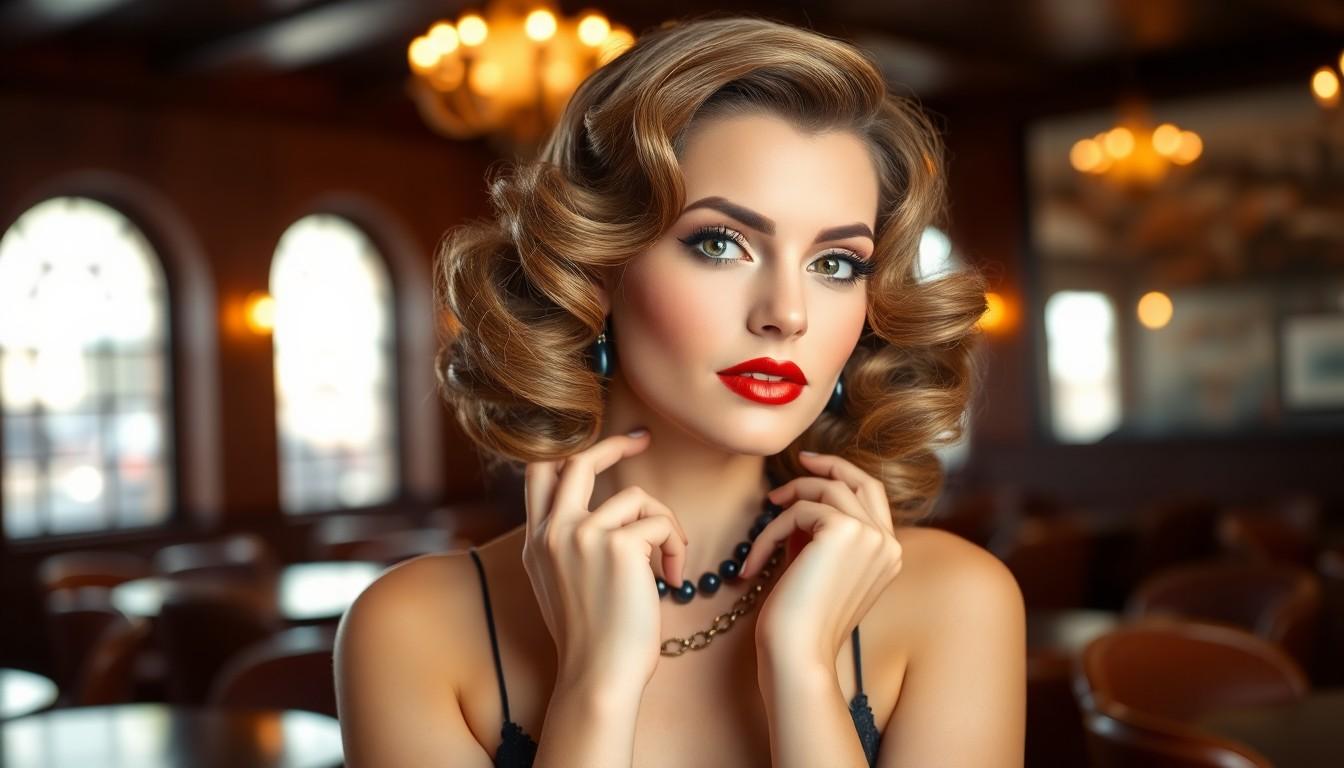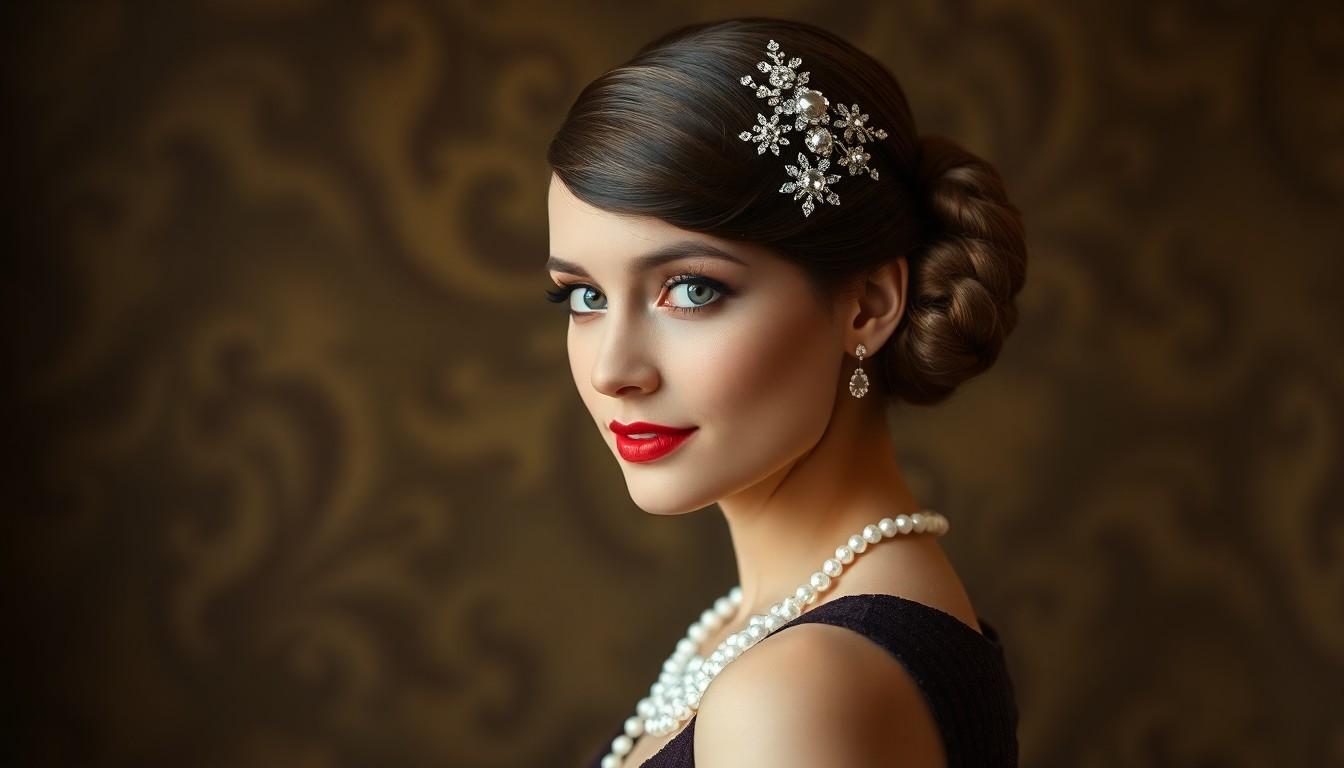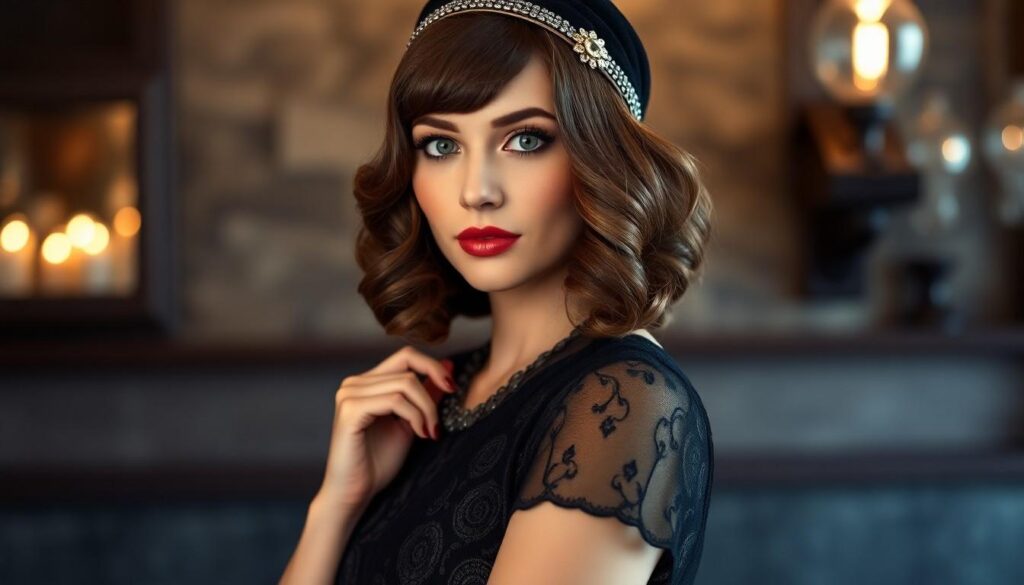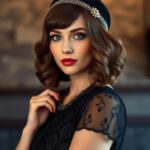There’s something magical about the bold spirit of the 1920s. The era wasn’t just about jazz and glitz—it was a revolution for personal style. We can’t help but be drawn to the daring confidence of women who chopped their locks and set new beauty standards with every wave and curl.
If we’ve ever longed for a look that’s timeless yet utterly chic the iconic hairstyles of the Roaring Twenties are calling our name. These styles aren’t just vintage—they’re a statement that says we’re ready to stand out. Let’s jump into the industry of finger waves bobs and glamorous accessories that still turn heads today.
Exploring Iconic 1920s Hairstyles
We instantly recognize the bob as the star of 1920s hairstyles. Women everywhere cut their hair short for the first time, choosing jaw-length or chin-grazing crops like the Louise Brooks bob. You could spot these bold shapes on movie screens and city streets, always paired with dramatic makeup.
Our admiration grows for finger waves, which offered soft movement to all types of short hair. Stylists used strict patterns to create S-shaped curves with wet fingers and metal combs. Each wave shimmered, especially under the speakeasy lights, showing off the era’s love of both structure and softness.
We also notice the Eton crop, one of the sleekest options. That style brought hair down to the scalp, sometimes slicked back with pomade to mimic a men’s haircut. You’d see fashion icons and flappers with hardly any length left, proving how far beauty standards shifted.
Waves and curls weren’t only daytime staples. Our inspirations looked to marcel waves too, which relied on heated irons. These tight, glossy waves covered parties and red carpets, showing off new technology alongside new style.
We love how cloche hats inspired blunt fringe cuts. Many women trimmed their bangs straight across the brows so hats would fit snugly. Each hat-and-hair combo gave them an instantly modern, put-together look, perfect for the fast-paced 1920s lifestyle.
Accessories mattered just as much as haircuts. We’d see sparkling headbands, feathered clips, and beaded combs complete every evening look, reminding us that glamour was always the goal in a truly Roaring Twenties style.
Embracing The Classic Bob Cut

We know the bob was more than just a trend in the 1920s—it was a statement about freedom and modernity. When Josephine Baker and Colleen Moore adopted this look, they made it the must-have cut of the decade. Let’s explore the different ways women made the bob their own.
Blunt Bob: The Signature Look
If we picture the classic 1920s hairstyle, the blunt bob comes to mind instantly. Women wore their hair straight around the jawline or just below, creating a bold, no-nonsense outline. Flat and sleek against the head, this look often called for hair products that kept every strand in place. For reference, when you look at old photos of flappers, you’ll usually spot a blunt bob with minimal layers and a crisp edge. Not only did this cut frame the face beautifully, but it also paired perfectly with the cloche hats and sparkling headbands popular at the time.
Sleek Eton Crop: The Ultra-Short Trend
Sometimes, bobs got even shorter with the introduction of the Eton crop. We notice this style left hair close-cropped, often with a straight fringe across the forehead. Many women embraced the Eton crop to show real confidence and modern edge. Stylists sculpted clean lines with gel or pomade, letting the geometric shape stand out. Women who wanted to break every mold in the 1920s often chose the Eton crop, making it a symbol of pure defiance and fashion-forward thinking.
Sporting The Wavy Finger Waves

Let’s talk about the iconic finger waves that defined 1920s style. We can instantly channel the glamour of that era by re-creating these perfectly sculpted, rippling waves.
Achieving Defined S-Shaped Waves
First, we’d prep our hair by washing it and letting it dry just enough to be workable. Next, we’d reach for a strong-hold hair gel or pomade, making sure to coat every strand for that crisp, shiny finish. Grabbing a fine-tooth comb, we’d guide the hair into distinct S-shaped curves, using our fingers to press and shape as we move. Pins or clips help us lock each wave in place as the gel sets, guaranteeing a high-shine, sculpted pattern that lasts. Women with short crops and those with longer lengths—the finger wave chignon worked wonders for both—used these same tools to get that unmistakable look.
Accessorizing Finger Waves For Glamour
Nothing complemented finger waves like the right accessories. Hats, especially close-fitting cloches, added both elegance and practicality, keeping every wave perfectly in place. Headbands—often bejeweled or beaded—brought a bold finishing touch, while silk turbans offered a hint of exotic flair. Decorative hairpins and brooches doubled as practical hair holders and statement pieces; a single sparkling pin could transform a simple chignon into a flash of 1920s nightlife. We’d always finish the look by pairing our glamourous hair with flapper dresses, dramatic necklaces, and a daring lip, completing the transformation into pure jazz-age sophistication.
Channeling The Glamorous Marcel Waves

Nothing evokes 1920s glamour quite like the marcel wave. We can instantly channel vintage Hollywood charm just by recreating these iconic, high-shine waves.
Creating Deep, Glossy Curls
Achieving marcel waves in the 1920s meant grabbing a heated curling iron for perfect, sea-like curves. Most women worked a strong-hold product into damp hair first, ensuring those elegant waves lasted through every Charleston. We’d take a fine-tooth comb and meticulously sculpt glossy S-shaped patterns, molding each section with steady fingers and securing them until set. Longer hair allowed for dramatic finger wave chignons at the nape, while bobs showcased the waves front and center.
Popularizing Marcel Waves Among Hollywood Stars
Hollywood stars made marcel waves a “must-have.” Josephine Baker’s luminous waves captured youth and freedom, making the style aspirational for fans worldwide. Mary Pickford, after embracing shorter cuts, helped shift the trend from ringlets to this bold new look. We watched as Colleen Moore and others carried marcel waves from silent films straight into mainstream style, proving that a little wave could say a lot about modernity and confidence.
Flaunting The Chic Shingle Bob

Let’s talk about why the Shingle Bob stood out as the statement hairstyle of the 1920s. The shape, style, and signature accessories combined to make this look a true icon of flapper fashion and independence.
Tapering Techniques For The Shingle Bob
Mastering the Shingle Bob meant perfecting precision tapering. We see stylists of the era cut the hair close at the nape, sculpting a crisp V-shape that hugged the neck for bold definition. Creating those clean lines on the sides, experts snipped hair just above the jawline to keep the silhouette sleek and modern, unlike anything seen before. Achieving that V at the back took careful sectioning and a steady hand, which not only highlighted the jaw and neck but also signaled a confident break from tradition.
Pairing Shingle Bobs With Vintage Accessories
Hats became a staple for those flaunting Shingle Bobs, with cloches and angled caps drawing attention to both the cut and the wearer’s poise. Adding a jeweled headband or a classic turban elevated the sophisticated vibe while keeping hair neat for jazz-filled nights. Finger waves often surfaced in this look, as many of us would blend in sculpted, shiny S-waves using strong gel and a fine-tooth comb to add drama or grace around the face. Jewelry choices, especially Art Deco barrettes and beaded earrings, completed the look, offering an extra hint of sparkle and reinforcing the era’s love for geometric decoration. For anyone seeking soft edges or added polish, sculpted edges with specialized gels made the Shingle Bob truly pop, celebrating the confident spirit of 1920s style.
Creating The Flapper Faux Bob

Sometimes we want that bold bob look without losing our length. The faux bob, or “nervous bob”, was our go-to trick in the 1920s for faking this iconic style.
Tucking Techniques For Longer Hair
Tucking was the secret behind our faux bobs. We’d fold our longer hair under at chin-level, using sturdy pins to hold everything in place, instantly transforming our look. Some of us drew inspiration from Mary Pickford and kept our hair in soft, curly ringlettes to add volume before tucking them beneath a headband or cloche hat. Many preferred the sleek, modern look, so we’d slick our hair back and gather everything into a neat low bun, making sure nothing escaped. For everyday style, both the faux bob and the low bun offered versatility while still letting us tap into the Jazz Age flair.
Decorative Headbands And Embellishments
Headbands weren’t just stylish—they helped us keep every strand in place. We chose everything from simple satin bands to pearl-embellished or beaded pieces that caught the light on a dance floor. Many of us loved slipping on hats, turbans, or even soft bandanas to protect our hair and add another layer of style. Pins and clips, sometimes sparkling with beads or delicate pearls, let us secure tucks and rolls with a touch of glamour. Decorative accessories turned practical hairstyles into statements, showing off our taste and finishing every faux bob with authentic 1920s attitude.
Experimenting With The Sleek Chignon And Bun Styles

Let’s explore how chignons and buns added a sophisticated flair to 1920s style. These sleek updos let us embrace both tradition and modern elegance, often paired with stunning accessories for maximum impact.
Low Nape Chignon For Evening Elegance
A low nape chignon quickly became our favorite for formal evenings. We gather the length of our hair at the nape, twisting it into a smooth coil that tucks neatly under. This timeless technique helps us achieve an elegant profile, especially when we want to keep long hair controlled and chic at special events. Stars that favored longer styles, like those imitating Mary Pickford’s looks, often chose this option for glamour. Sometimes our chignon got an upgrade with soft finger waves, paving the way for the finger wave chignon—a dramatic blend of vintage wave patterns and sleek updo refinement.
Decorative Combs And Hairpins Of The Era
Decorative combs always brought a dose of glamour to our updos. Ornate materials, including embellished metal and sparkling rhinestones, made these combs both practical and ornamental for styles like chignons and buns. We relied on intricately designed hairpins to secure and accentuate our styles, making sure pins offered both hold and visible elegance. These accessories didn’t just keep everything in place—they were essential for completing the authentic 1920s look, reflecting the flair and desire for stylish self-expression during the decade.
Styling For Special Occasions: 1920s Updos

Special occasions in the 1920s called for hairstyles that truly captured the era’s sense of glamour and luxury. We saw women embracing carefully structured updos, often made even more striking with sparkling touches and clever design.
Rolled Updos With Ornate Embellishments
Women attending high-profile events loved the drama of a classic rolled updo or bun, using smooth rolling and tucking methods to keep hair flat or neatly positioned at the nape. Jewel-covered combs and gold-accented pins added instant sophistication, making the entire look shimmer under evening lights. Gilded updos stood out as a status symbol, combining velvet-sheen hair with delicate padding for volume, while accessories like pearls or gemstone bands elevated each style. Many of us would recognize this detailed approach from red carpet appearances and vintage photos where elegance was non-negotiable.
Side-Parted Styles For Dance Halls And Parties
Many dance hall regulars found side-parted hairstyles both fashionable and low maintenance. Women with long hair often went for slicked-back ponytails or subtle, soft waves parted deeply to one side for a touch of classic glamour. Sleek, manageable styles—such as the “cootie garage” look with carefully placed buns on each side—became go-to choices for those who wanted to keep hair neat while enjoying a night out. Some partygoers finished the ensemble with fun embellishments or subtle finger waves, bringing both style and practicality to every celebration. We can still see echoes of these creative updos and side-parted looks in vintage-themed events and retro-inspired weddings today.
Accessorizing 1920s Hairstyles

Sometimes, it’s the accessories that truly captured the magic of 1920s hairstyles. We saw every flapper and socialite topping off finger waves and bobs with dazzling, unforgettable pieces. These accents didn’t just hold styles in place—they turned simple cuts into shimmering statements of individuality.
Feather Headbands And Jeweled Barrettes
Feather headbands became a symbol of flapper chic, adding softness and bold drama to both short and long hair. Our favorites usually featured luxurious feathers, shining beads, or sparkling decorative touches, taking evening looks to glamorous new heights. Jeweled barrettes secured waves and bobs while providing a glint of style; those adorned with gems or Art Deco motifs instantly dressed up any hairstyle for a night out. We noticed women using simple gem-set barrettes for daytime charm and switching to heavily embellished versions for cocktails and soirees.
Scarves, Tiara, And Vintage Hair Clips
Scarves played a versatile role in 1920s hairstyling. We loved wrapping lightweight scarves as chic headbands, tying them in turban styles, or smoothing hair back for that effortless jazz age sophistication. With tiaras, even everyday looks became expressions of luxury and rebellion—flappers and high-society trendsetters often wore these sparkling crowns to give short crops and bobs that signature “it-girl” allure. Vintage hair clips weren’t just functional; beautifully decorated options with pearls, beads, or metallic finishes held bobs and finger waves in place all day. Our creative styling combined these clips for both sleek control and subtle elegance, completing the glamorous looks that have come to define 1920s spirit.
Adapting 1920s Hairstyles For Modern Looks

Bringing 1920s hairstyling into the modern era lets us blend vintage charm with new techniques. We can easily refresh any classic flapper look with today’s products and tools.
Modern Interpretations Of Classic Styles
Finger waves still turn heads at special events or nights out. We get that signature wavy texture using strong-hold gel and a fine-tooth comb, smoothing each S-shaped wave into place. Longer hair works beautifully for a finger wave chignon, which keeps waves polished and tucked away for a timeless look.
Bob variations are everywhere now, adapting to all hair textures and face shapes. Modern hair straighteners and texturizing spray give our bobs some edge—think angled or tousled finishes for everyday wear, while keeping the essence of the 1920s cut alive.
Curly styles like Mary Pickford’s ringlets remain a playful choice. Curling irons and flexible hairsprays help us shape defined, bouncy curls, whether we leave them loose or gather them into a pinned-back updo for that iconic vintage vibe.
Tips For Achieving 1920s Glam With Today’s Tools
Using the right products is crucial. We reach for firm-hold hair gel or pomade to mold finger waves, while light-hold hairspray locks in soft curls without stiffness.
Sculpted edges shape our hairlines in classic 1920s fashion. We rely on edge-controlling gels or taming creams to define and maintain those sleek lines.
Accessories truly complete the look. We add velvet headbands, art deco barrettes, or a classic hat to nod to the roaring twenties and keep hair neatly in place.
Hairstyling tools simplify everything. Flat irons, curling irons, and hair dryers make it easy for us to achieve a glossy finish or sculpted silhouette—just like our flapper predecessors, but in half the time.
Conclusion
Exploring 1920s hairstyles reminds us that style is about more than just looks—it’s a celebration of confidence and creativity. When we draw inspiration from this iconic era we’re embracing a spirit of individuality that still resonates today.
Whether we’re channeling the sleek lines of a bob or adding a touch of vintage flair with glamorous accessories these timeless styles invite us to express ourselves boldly. Let’s keep the roaring twenties alive by making these classic looks our own in fresh new ways.
Frequently Asked Questions
What were the most iconic 1920s hairstyles for women?
The most iconic 1920s hairstyles included the bob, finger waves, Eton crop, marcel waves, shingle bob, faux bob, and sleek chignons or buns. These styles reflected the era’s spirit of independence and modernity among women.
What is a finger wave and how is it made?
A finger wave is a 1920s hairstyle featuring sculpted, “S”-shaped waves. It’s achieved by applying strong-hold gel or pomade and shaping the hair with a fine-tooth comb and pins to create defined, glossy waves.
Why was the bob haircut so popular in the 1920s?
The bob haircut became popular as a bold symbol of freedom and modernity. It represented a break from tradition, emphasizing women’s independence and a shift toward a more daring, chic personal style.
How do you create a faux bob hairstyle?
To create a faux bob, longer hair is curled or tucked under and pinned at the nape to mimic a shorter bob cut. This temporary style offers the bob’s fashionable look without actually cutting your hair.
What accessories were popular for 1920s hairstyles?
Popular 1920s hair accessories included cloche hats, feather headbands, jeweled barrettes, decorative combs, and art deco pins. These items complemented hairstyles and added glamour and individuality to every look.
Can 1920s hairstyles be adapted for modern fashion?
Yes, 1920s hairstyles can be adapted for modern fashion. Finger waves and various bob cuts can be updated using today’s tools and products, offering a vintage-inspired look that’s both timeless and chic.
What was the significance of finger and marcel waves in the 1920s?
Finger and marcel waves symbolized sophistication and Hollywood glamour in the 1920s. They were fashionable for their soft, sculpted curves, and represented new beauty standards influenced by celebrities and new styling technology.
How did 1920s hairstyles reflect women’s changing roles?
1920s hairstyles, especially short cuts like the bob and Eton crop, expressed independence, confidence, and rebellion against traditional gender roles. These bold looks mirrored women’s increasing social freedom during the era.
Are special products needed to recreate 1920s looks today?
To recreate authentic 1920s hairstyles, it’s recommended to use strong-hold gel or pomade, a fine-tooth comb, hairpins, and shine sprays. Modern heat tools also help achieve waves and sleek styles efficiently.
What events or outfits work best with vintage 1920s hair?
Vintage 1920s hairstyles pair perfectly with flapper dresses, evening gowns, and themed parties. They work well for special occasions like weddings, costume parties, or any event where you want a glamorous, retro touch.







